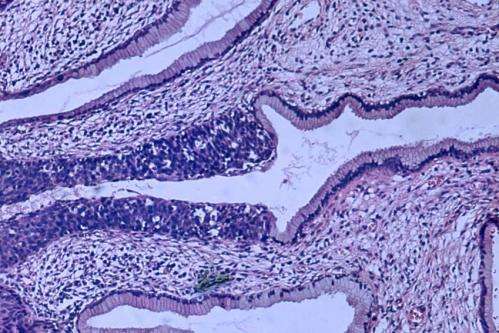
A predictive model estimated that cervical cancer may be virtually eliminated in the United States by 2030 in communities with low poverty rates, but not until 2044 in communities with high poverty rates, according to a study published in Cancer Epidemiology, Biomarkers & Prevention, a journal of the American Association for Cancer Research.
“Other studies have predicted that, as a whole, the U.S. will hit the elimination target in the middle of that range,” said Jennifer Spencer, Ph.D., lead author of the study and an assistant professor at the University of Texas at Austin, who performed this work as a research fellow at the Harvard School of Public Health. “The fact that some places will hit it a decade before other places is a little bit of a gut punch.”
Approximately 14,000 cases of cervical cancer are diagnosed per year in the U.S., resulting in an estimated 4,000 annual deaths. Over 90 percent of cervical cancers are caused by infection with certain types of human papillomavirus (HPV), a sexually transmitted infection that can also cause anal, penile, vaginal, vulvar, and oropharyngeal tumors.
HPV vaccines have been available since 2006 and currently protect against nine HPV types, including seven of the 14 known to increase cancer risk. A full vaccination regimen is recommended for all adolescents and consists of two doses for children aged nine to 15 or three doses for individuals aged 15 to 26. Because the vaccine is over 90 percent effective at preventing HPV-related cancers, vaccination efforts could lead to “near-elimination” of cervical cancer, a threshold the World Health Organization defines as fewer than four cases per 100,000 individuals.
Because most cervical cancers occur in patients older than 30, and the first adolescents to be vaccinated are only beginning to enter that age range, scientists cannot yet quantify the effects of widespread vaccination efforts. It can therefore be difficult to determine where disparities exist and design plans to mediate them. For this, researchers like Spencer have turned to predictive models.
Spencer and her colleagues created a model of HPV spread and progression, based on previous models used to understand sexually transmitted diseases. Their model accounted for the risk of HPV transmission among vaccinated and unvaccinated individuals, the probability of HPV progressing to cervical cancer, the rates of cervical cancer screening, and the odds of effective cancer treatment.
The researchers developed two versions of the model—one of a hypothetical county in the lowest poverty quartile and one of a county in the highest poverty quartile. They acquired immunization data for low- vs. high-poverty areas from the National Immunization Survey-Teen (NIS-Teen), screening and follow-up data from the National Health Interview Survey (NHIS), and HPV prevalence data from the National Health and Nutrition Examination Survey (NHANES).
The models that best matched existing data for the low- and high-poverty scenarios were then used to simulate cervical cancer rates through 2070. The researchers ran the simulation using the current vaccine initiation rate (anyone who has received at least one dose) of approximately 70 percent in both high- and low-poverty counties, as well as the national target vaccination rate of 80 percent.
The models predicted that low-poverty areas will reach the cervical cancer near-elimination threshold by 2030, while high-poverty areas won’t reach this threshold until 2044. This resulted in an estimated 21,604 excess cervical cancer cases in high-poverty areas over the next 50 years. However, the absolute disparity in cervical cancer rates is expected to decrease from an estimated 2.5 excess cases per 100,000 women in high-poverty areas in 2006 to an excess 1.0 case per 100,000 women in high-poverty areas in 2070. The model did not predict that cervical cancer would be eliminated much sooner in either area if vaccination rates reached 80 percent, but that such efforts would decrease the number of excess cases in high-poverty counties by around 1,000 over the next 50 years.
Spencer does not believe that these disparities are due to differences in vaccination rates, as the study showed similar vaccination rates in high-poverty and low-poverty areas. Instead, the study confirmed known differences in cervical cancer screening rates between high- and low-poverty counties and additionally found that high-poverty counties have a higher prevalence of cancer-causing HPV types that aren’t covered by the vaccine—18.3 percent compared to 8.9 percent in low-poverty counties. Spencer believes that these factors may contribute to the disparities.
“Vaccination can do a lot of good, but it’s unlikely that the disparities can be addressed through just vaccination,” Spencer said. “The next step is to identify what policies we can use to close these gaps in the future.”
Source: Read Full Article